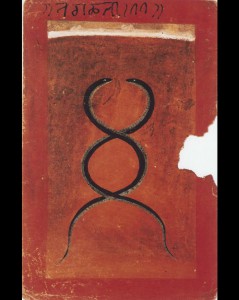ANONYMOUS DREAM SUBMISSION – WHITE SNAKE DREAM INTERPRETATION
Aloha Dr. Howard,
I just woke up and the last dream I can recall was I was walking through an airport with a piece of rolling carry on luggage; and the luggage was designed to hold this white snake. I was transporting it for a friend. And every time I looked down at the snake it had extended its body a little and was getting closer to my hand. I eventually dropped the suitcase for fear of being bitten.Earlier in the night, I had another dream that contained a white snake; but I do not remember what I was doing in the dream.
So I guess the snake is the star here. What is that all about?
Snakes are one of the most important symbols of primal energy of the psyche. It is sacred to the divine healer, Asclepius of ancient Greece, who has embodied the daemon of “genius” intertwined with a black and white snake on his staff. Snakes are hidden forces, often dark and cold. They often accomplish the miracle of cure. They are an ominous warning, an awakening of a primal energy in your psyche. A serpent is an emblematic, primordial life force. Your psyche is asking you to not only transport some primal energy that your friend has, but also to take ownership of that quality in yourself that you are you are afraid of.
Bitting in a dream has a double meaning. It is your psyche insisting that you ingest and not be afraid of some primal instinct that is emerging in your life. It is like an imprint or seal of spirit that wants you to recognize its place in your life. Or it can signify a sudden and dangerous action of an instinct in your life.
A state of whiteness indicates that some part of us is not living and remains in an abstract or ideal state. That part wants to be embodied into your life. Baptism or initiates wear white vestments of rebirth, for simplicity and restoration. White can also mean a cold force, like that of the mythic Snow Queen of the north. In Moby Dick the Great White Whale conveys the indefiniteness and impersonal vastness of the universe and the human fears of annihilation. Yet the milky maternal ocean of Hindu myth speaks of the source of all the fundaments of the cosmos. In alchemy the whiteness or albedo was conceived as a state of illumination of the dawning the unknown personality into consciousness. Birth this part of yourself.
Hope this helps,
Dr. Howard Teich

